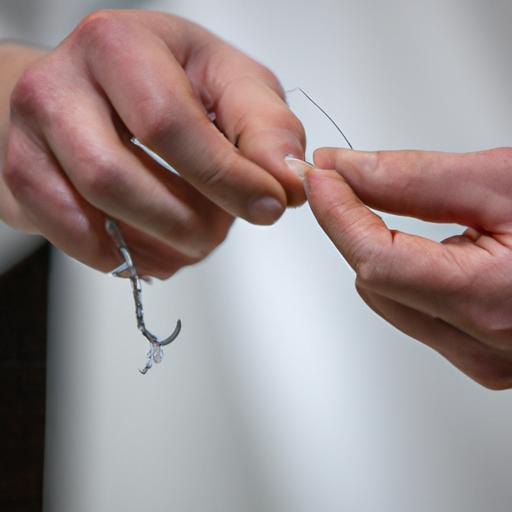When it comes to the world of fishing, tying a hook onto your line may seem like a relatively simple task. However, mastering the art of tying a fishing hook on a line is crucial for ensuring a successful angling experience. Whether you’re a seasoned fisherman or just starting out, understanding the proper techniques and knots to secure your hook can make all the difference in catching that prized fish.
Why is knowing how to tie a fishing hook on a line important?
Imagine this: you’re out on the tranquil waters, surrounded by nature’s beauty, and you cast your line with anticipation. Suddenly, you feel a tug – a bite! But as you reel in your line, disaster strikes – the hook comes loose, and your catch swims away. Frustrating, isn’t it?
Knowing how to tie a fishing hook on a line properly is essential for several reasons. Firstly, a securely tied hook ensures that your bait remains in place, increasing the chances of enticing a fish to bite. Secondly, a well-tied knot provides strength and resilience, preventing the hook from slipping or breaking loose during a struggle with a mighty fish. Lastly, by mastering this skill, you gain confidence in your angling abilities, allowing you to fully immerse yourself in the joy of fishing without worrying about losing your catch.
The benefits of using proper techniques for successful fishing
Using proper techniques to tie a fishing hook on a line offers a multitude of benefits. Firstly, it enhances your fishing success rate by increasing the likelihood of attracting fish to your bait and effectively hooking them. A secure knot ensures that your hook is positioned correctly, maximizing your chances of a successful catch.
Moreover, employing the right techniques minimizes the risk of losing your hook, bait, or even the fish itself. Imagine the disappointment of losing a trophy fish due to a poorly tied knot. By utilizing proper techniques, you can avoid such heart-wrenching scenarios and enjoy the satisfaction of landing your prized catch.
Additionally, using correct knotting techniques allows for efficient bait presentation. A well-tied hook ensures that your bait moves naturally in the water, mimicking the behavior of real prey and enticing fish to strike. By achieving a seamless presentation, you significantly increase your chances of attracting even the wariest of fish.
In the following sections, we will delve deeper into the fundamental equipment required for tying a fishing hook, explore various knot options, and provide a step-by-step guide to help you master the art of tying a fishing hook on a line. So, let’s dive in and embark on this angling journey together!
Understanding the Basic Equipment
Different Types of Fishing Hooks and Lines
When it comes to fishing, understanding the basic equipment is essential for a successful angling experience. Let’s start by exploring the different types of fishing hooks available. From the classic J-hook to the specialized circle hook, each hook serves a unique purpose.
1. J-Hook
The J-hook is a versatile and widely used hook that resembles the letter “J.” It is suitable for various fishing techniques and can be used with both live bait and artificial lures. The J-hook comes in different sizes, with larger hooks typically used for bigger fish species.
2. Circle Hook
The circle hook is designed to minimize injury to fish, making it a popular choice among catch-and-release anglers. Its unique circular shape and inward-pointing hook make it more likely to hook the fish in the corner of its mouth, increasing the chances of a successful release.
3. Treble Hook
The treble hook consists of three hooks merged at a single point, forming a formidable trio. It is commonly used in lure fishing and is particularly effective in hooking fish that strike aggressively. Anglers often choose treble hooks based on the size and strength required for their target species.
Moving on to fishing lines, various types are available, each with its own strengths and applications.
1. Monofilament Line
Monofilament line is a popular choice due to its versatility and affordability. It is a single-strand line that offers good knot strength, low visibility in the water, and decent abrasion resistance. Monofilament lines are suitable for a wide range of fishing techniques and can be used in both freshwater and saltwater environments.
2. Fluorocarbon Line
Fluorocarbon line is known for its excellent visibility properties, making it virtually invisible underwater. It offers high resistance to abrasion and is less likely to stretch compared to monofilament lines. Fluorocarbon lines are popular for finesse fishing and when targeting finicky fish species.
3. Braided Line
Braided line, also known as superline, is made of multiple strands of synthetic fibers woven together. It provides exceptional strength, sensitivity, and a small diameter, allowing for longer casts and increased sensitivity to detect subtle bites. Braided lines are excellent for fishing in heavy cover or when targeting large, aggressive fish.
Selecting the Right Hook and Line for the Fishing Technique
Choosing the appropriate hook and line for your fishing technique is vital to ensure success on the water. Consider the following factors when making your selection:
-
Target Species: Different fish species have different feeding habits and mouth structures. Understanding your target species’ preferences will help you determine the appropriate hook size, shape, and line strength.
-
Fishing Technique: The fishing technique you plan to use plays a significant role in selecting the right equipment. Whether you’re casting, trolling, or bottom fishing, matching your hook and line to the technique will optimize your chances of success.
-
Environmental Factors: Consider the fishing conditions, such as water clarity, depth, and structure. These factors can influence the visibility of your line and the type of hook that works best in the given environment.
By understanding the types of fishing hooks and lines available and selecting the right ones for your fishing technique, you’ll be well on your way to mastering the art of angling. Up next, we’ll explore the importance of choosing the right knot for tying your fishing hook securely.
Choosing the Right Knot for Tying the Fishing Hook
The Significance of Using the Appropriate Knot for Securing the Hook
When it comes to tying a fishing hook on a line, the type of knot you choose plays a crucial role in ensuring its security and reliability. The right knot not only keeps your hook firmly attached but also enhances its strength, allowing you to handle the toughest of fish without fear of losing your catch. With countless knot options available, it’s important to understand their differences and select the most suitable one for your fishing needs.
An Overview of Various Fishing Knots Commonly Used
-
Improved Clinch Knot: This popular knot is known for its simplicity and effectiveness. It is widely used for attaching hooks, lures, and swivels to the fishing line. The improved clinch knot is easy to tie and provides excellent strength, making it a reliable choice for various fishing scenarios.
-
Palomar Knot: Considered one of the strongest knots, the palomar knot offers exceptional reliability, particularly when using braided or heavy lines. Its straightforward tying process makes it a favorite among anglers, securing hooks and lures with unparalleled strength.
-
Uni Knot: Versatile and easy to tie, the uni knot is suitable for both monofilament and braided lines. It provides reliable strength and allows for smooth movement, making it an excellent choice for attaching hooks, swivels, and other terminal tackle.
-
Snell Knot: Ideal for live bait fishing, the snell knot ensures that the hook is positioned correctly, increasing hook-up rates. This knot is particularly effective for hooks with an offset eye, allowing the bait to present a natural and enticing appearance.
The Importance of Knot Strength and Reliability
When tying a fishing hook on a line, knot strength and reliability are paramount. A weak or poorly tied knot puts your entire fishing setup at risk. A knot that fails under pressure can result in lost fish, lost hooks, and lost opportunities.
To ensure knot strength, it’s crucial to follow proper tying techniques and use the appropriate amount of tension while cinching the knot. Additionally, regularly inspecting your knots for signs of wear or damage is essential, as worn-out knots can compromise their strength and integrity.
Remember, the knot is the vital link between you and the fish. By choosing the right knot and ensuring its strength and reliability, you can approach your fishing adventures with confidence, knowing that your hook is securely fastened and ready to land that elusive catch.
Step-by-Step Guide: Tying the Fishing Hook on the Line
Ready to become a master of tying fishing hooks? Follow these step-by-step instructions to ensure a secure and reliable knot every time.
Step 1: Preparing the line and hook
Before diving into the knot-tying process, make sure your line and hook are ready for action. Ensure that the line is untangled and free from any knots or twists. Take your fishing hook and inspect it for any damage or rust. A well-maintained hook increases your chances of a successful catch.
Step 2: Threading the line through the hook eyelet
Take the tag end of your fishing line and thread it through the eyelet of the hook. Gently pull the line through, leaving a few inches of tag end to work with. This step is crucial for setting up the foundation of your knot.
Step 3: Forming the initial loop
Hold the tag end and the mainline together, forming a loop with your fingers. Ensure that the loop is large enough to work with comfortably but not too big that it becomes cumbersome.
Step 4: Creating the knot by wrapping the line around the hook shank
Take the tag end of the line and wrap it around the hook shank, making five to seven turns. Keep the wraps tight and evenly spaced to ensure a strong and secure knot.
Step 5: Securing the knot by passing the line through the loop
Carefully pass the tag end of the line through the loop you formed in Step 3. Ensure that the tag end goes through the loop from the same side as the mainline. This will create a second loop around the hook shank.
Step 6: Tightening the knot and trimming any excess line
Hold the hook and standing line firmly, while pulling the tag end slowly to tighten the knot. Make sure the knot is snug and secure, but be cautious not to over-tighten and weaken the line. Once the knot is tightened, trim any excess tag end, leaving a small tag for added security.
Congratulations! You’ve successfully tied your fishing hook onto the line. Remember to practice these steps multiple times to develop muscle memory and increase your efficiency. With time and experience, you’ll become a pro at tying fishing knots, ensuring a fruitful angling adventure every time.
Tips for Ensuring a Secure Knot
Avoiding Common Mistakes When Tying the Knot
Tying a secure knot is crucial for a successful fishing expedition. However, it’s easy to fall into common pitfalls that can compromise the strength and reliability of your knot. Here are some valuable tips to help you avoid these mistakes and tie a knot that will withstand the test of time and the tug of a formidable fish:
-
Take your time: Rushing through the knot-tying process can lead to sloppy and weak knots. Instead, find a calm and steady rhythm, focusing on each step of the knot to ensure accuracy and tightness.
-
Moisten the line: Before tying the knot, moisten the line with saliva or water. This lubrication helps reduce friction and allows the knot to cinch tightly without damaging the line’s integrity.
-
Maintain tension: Throughout the knot-tying process, make sure to maintain consistent tension on the line. This tension ensures that the knot is properly tightened and reduces the risk of slippage.
Testing the Knot’s Strength Before Casting
Before casting your line into the water, it’s essential to test the strength of the knot. After all, you wouldn’t want to lose a potential trophy catch due to a weak knot. Here’s a simple method to check the knot’s strength:
-
Apply steady pressure: Hold onto the line near the knot and apply steady pressure to test its resilience. Gently pull the line in different directions, gradually increasing the force to simulate the resistance of a hooked fish. If the knot holds firm without slipping or unraveling, you can have confidence in its strength.
-
Inspect for any signs of weakness: While applying pressure, keep a keen eye on the knot for any signs of weakness, such as visible slippage or unraveling. If you notice any issues, it’s crucial to re-tie the knot to ensure a secure connection.
Reinforcing the Knot for Added Security
To provide added security to your knot, consider reinforcing it with a few simple techniques. These reinforcements can help prevent knot failure and give you peace of mind during your fishing escapades:
-
Double knot or loop: If you want extra assurance, consider tying a double knot or loop. This involves repeating the knot-tying process once more, creating a second layer of security.
-
Using a backing knot: Another effective method is to tie a backing knot, such as the “double surgeon’s knot” or the “improved clinch knot.” The backing knot acts as a safeguard by providing an additional layer of strength to the main knot.
By implementing these tips and techniques, you can significantly increase the reliability and durability of your knot, ensuring that it remains secure even when faced with the most vigorous fish or challenging fishing conditions. Now that you’re equipped with these valuable insights, let’s move on to the final section where we’ll summarize the significance of mastering the art of tying a fishing hook on a line.
Conclusion: Unleashing Your Fishing Potential
In conclusion, mastering the art of tying a fishing hook on a line is an essential skill for any angler seeking success on the water. By understanding the importance of using proper techniques, you can significantly enhance your fishing experience and increase your chances of reeling in that prized catch.
Throughout this article, we have explored the significance of securely tying a fishing hook, highlighting the benefits of employing the right techniques. From ensuring bait presentation to preventing hook slippage, each aspect contributes to the overall effectiveness of your angling endeavors.
Remember, practice makes perfect! Take the time to familiarize yourself with different knots and experiment with various techniques. As you gain proficiency, you’ll find yourself tying knots with ease and confidence, ultimately elevating your angling prowess.
So, whether you’re casting your line into a serene lake or battling the waves of the open sea, the knowledge and skills you’ve acquired in tying a fishing hook on a line will serve as your trusted companion. Embrace the excitement, the challenge, and the rewards of the fishing journey, knowing that you have the expertise to secure your hook and seize the moment when opportunity bites.
Now, armed with this newfound knowledge, it’s time to venture out and put your skills to the test. So go ahead, tie that hook, cast your line, and embrace the thrill of the angler’s pursuit. Happy fishing!



